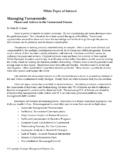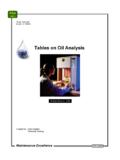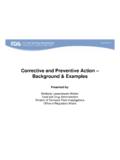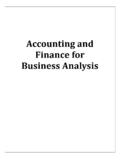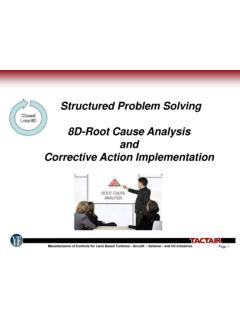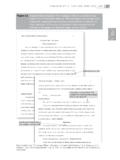Transcription of A Gap Analysis Review and Action Plan …
1 A Gap Analysis Review and Action plan recommendations relative to USP Chapter <797>. Prepared for XX Medical Center By Eric S. Kastango, MBA, RPh, FASHP. Clinical IQ, LLC. and James T. Wagner Controlled Environment Consulting Confidential and Proprietary For Internal Use Only Table of Contents Overview page 3. Operational Analysis page 4. Facility recommendations page 5. Operational recommendations page 9. Handling and Preparation of Hazardous Drugs page 10. Cost Estimates/Budgetary plan page 13. Sample Floor plan -XX Division page 15.
2 Summary page 16. Confidential and Proprietary For Internal Use Only USP Chapter <797> Gap Analysis Page 3 of 16. X Medical Center Overview XX Medical Center 0000 X Avenue XX, XX. On August 24, 2005, Eric S. Kastango, MBA, RPh, FASHP, and Jim Wagner visited with XX, QA. Pharmacist of XX Medical Center (XX). The purpose of the visit was to conduct a one-day tour of the XX and XX Divisions of XX with the following objectives: Review current compounding operations, processes, and quality systems as they relate to the requirements detailed in USP Chapter <797>, Pharmaceutical Considerations: Sterile Preparations.
3 Review the gap analyses that were conducted by XX;. Provide a report and recommendations for an Action plan in order to meet both short- term and long-term goals for compliance with the requirements of USP Chapter 797. The report will also include suggestions on engineering controls and/or optimized cleanroom floor plans that can be provide to hospital engineering and/or contractors. Time was spent touring both campuses, during which the compounding, main pharmacy, and warehouse areas were inspected. Time was also spent in extensive conversation with XX Smith.
4 The aseptic compounding behaviors of pharmacy personnel were observed at both hospital campuses, and policies and procedures and quality assurance documentation were reviewed. Direct observations of personnel compounding procedures and the discussions with XX provided insight relative to the departments' understanding of the required elements of USP Chapter <797. XX. has conducted an extremely accurate gap Analysis and identified several issues that were confirmed by the consultants along with other opportunities for improvement, included in this report.
5 Pharmacies in the State of XX are in a unique situation in terms of compliance with state and USP. regulations. They are required to comply with both USP Chapter <797> and with the XX Board of Pharmacy Practice Act and Regulations. However, there are discrepancies between these two documents that need to be considered. The XX Board is in the process of reviewing the subchapter and determining how to harmonize the XX regulations with those in the USP chapter. It must be stressed that the failure to comply with the requirements in USP Chapter <797> places patients at greater risk of injury or death and makes the hospital system more liable to litigation in the event of such an occurrence.
6 Although there has been little or direct punitive actions taken against hospital pharmacies to date, there continues to be a significant number of cases concerning patient morbidity and mortality from contaminated sterile preparations. Compliance should not be viewed as optional. Confidential and Proprietary For Internal Use Only USP Chapter <797> Gap Analysis Page 4 of 16. X Medical Center Operational Analysis The overall impression of hospital pharmacy is that while significant progress has already been made towards compliance and a blueprint for success has been laid out in the hospital's policies and procedures, there exists a lack of employee compliance with these policies and procedures and a lack of true understanding of professional responsibility relative to the principles of contamination control and aseptic compounding as they are clearly defined in USP Chapter <797>.
7 In any quality system, the most important factor is management commitment. The management and employees need to have the correct attitude if their quality system program is to be effective. Quality consciousness should be developed in every employee. Each employee should be made aware of the importance of his or her individual contributions in the overall effort to achieve an acceptable level of quality. For each of the requirements within the USP chapter there are evidence-based practices known to minimize the risks associated with aseptic compounding, many that requires employee compliance.
8 After a quality system is in place and checked, it should not be allowed to stagnate -- it should continue to be dynamic. The system remains dynamic through continuous feedback, "big-picture". monitoring by system audits, management Review , and corrective and preventive Action . There are several other areas of concern that were discovered during this visit. They include the following: The physical space of the XX pharmacy is inadequate to perform the critical tasks in both the compounding and general pharmacy work areas.
9 There was inadequate room for gowning, product staging and checking, labeling of compounded sterile preparations (CSPs), and storage of the CSPs prior to their delivery to the patient care units. The personnel observed compounding CSPs did not follow standards of practice relative to procedures for hand washing, garbing, and gloving. Operators working at the XX facility gown up outside the room prior to entry. Gowning included a smock, face mask, hair net, and booties, all of which were done outside the room. Gowning should be occurring inside of the anteroom where the environment conditions (particles, etc) are controlled.
10 Hand-washing was not part of the gowning process. Compounding personnel, in full garb, were observed walking around outside of the compounding room in the XX division pharmacy talking with other employees. A pharmacist at the XX Division was observed compounding medications without first washing her hands or removing jewelry and makeup. The maximum beyond-use dating (BUD) for CSP formulations under frozen conditions ( 20 C) is 45 days. There were XX syringes found labeled with BUD of 6 months. Although, there may be chemical stability data to support this six month dating, USP Chapter <797> requires those CSPs whose BUD exceeds published ranges be sterility tested according to the requirements of USP.
